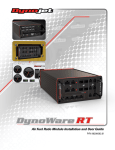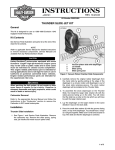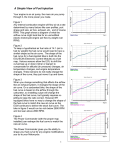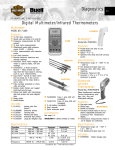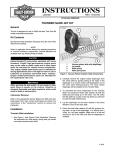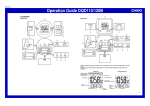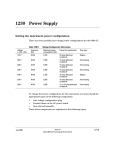Download INSTALLATION gUIDE
Transcript
I nstallation g uide This guide covers Auto Tune for Power Vision Part Numbers: AT110/AT-110B and AT120/120B Parts List 1- Auto Tune module 1- CD-ROM 1- Installation Guide 1- 72” Can to Can Cable 1- Y-Adapter Cable 1- CAN Termination Plug 2- 18mm O2 Sensors 1- 52”O2 Sensor Cable 1- 24”O2 Sensor Cable 3 -8” Cable Ties 2- Dual Lock Velcro 1- Alcohol swab 2- O2 Sensor Bungs O2 Sensor Bungs Included with Auto Tune AT-110b and AT-120B Kits ! ! ! I M P O R TA N T P L E A S E R E A D F I R S T ! ! ! This kit is designed to be used exclusively with the Dynojet Power Vision. The Auto Tune module by itself does not tune your vehicle; rather it transmits wide band Air-Fuel Ratio (AFR), or more precisely, Lambda values to the Power Vision. This data is critical to determine exactly how rich, or how lean your vehicle is running. Unlike narrow band oxygen sensors, the Bosch wide band sensors included in this Auto Tune kit are extremely accurate at all operating ranges of your vehicle. In order to get the most from your Auto Tune kit, you must use a software application called Log Tuner. The AFR, or Lambda data and other pertinent information from the H-D ECM are captured in a log file generated by the Power Vision. This data is then processed by the Log Tuner software in order to create a value file that contains information to correct VE (volumetric efficiency) tables in your tune file. Using Log Tuner in conjunction with your Power Vision and Auto Tune ensures you’ll end up with a safe, and powerful tune. SOFTWARE AND OTHER TECHNICAL INFORMATION ARE AVAILABLE ONLINE AT: W W W . F L A S H YO U R H A R L E Y. C O M . AT-110/120 2191 Mendenhall Drive North Las Vegas, NV 89081 1-800-992-4993 www.dynojet.com Auto Tune Installation- 1 The Auto Tune module requires the use of (2) 18mm O2 sensors. If your bike’s exhaust system doesn’t have bungs pre-installed, bungs will have to be welded into the header pipes to use this module. Please refer to page 3 for bung installation. FIG. A 1. Locate the diagnostics port on your motorcycle. This may require the removal of the seat and some body panels. Note: The location of the diagnostic port varies depending on model, so please refer to a service manual or contact Dynojet for the exact location. Use caution: Many models use the same style connector for accessories. Your Power Vision MUST be connected to the diagnostic port. Diag n cs osti Por t FIG. B 2. Locate a secure location to mount the Auto Tune module. On most models the module can be mounted under the seat or under a side cover. Note: Keep module and wiring away from moving parts to prevent damage. 3. Install both O2 sensors into the exhaust system. First connect the long O2 sensor harness to the front O2 sensor and route harness along the frame. Next connect the short O2 sensor harness to the rear O2 sensor and route harness along the frame. Note: Keep harness away from Hot and moving parts to prevent damage. See Fig. B REAR O2 SENSOR Connect the rear O2 sensor harness to Auto Tune module input #2 per Fig. C. Note: The harness can be cut to length if desired. 1 2 4. Connect the front O2 sensor harness to Auto Tune module input #1 per Fig. C. WHITE GREY BLACK YELLOW RED BLUE WHITE GREY BLACK YELLOW RED BLUE FRONT O2 SENSOR FIG. C AT-110/120 Auto Tune Installation- 2 FIG. D FROM AUTOTUNE FROM POWER VISION 5. Connect the Supplied Y-Adaptor to the Diagnostics port on the motorcycle. Route and connect the power lead from the Auto Tune module to one side of the Y-adaptor. Connect the Power Vision to the unused side of the Y-adaptor. DIAGNOSTIC PLUG Y-ADAPTER TO VEHICLE FIG. E 6. Connect the CAN Bus cable to the Auto Tune module. Route cable to the Power Vision and secure. 7. Install the CAN Termination plug into the unused port on the Auto Tune module. Note: This has to be done or the Power Vision will not be able to communicate with the Auto Tune module. See Fig. E. 8. Secure the Auto Tune Module with the supplied Velcro. 9. Secure any remaining sections of the wiring for the Auto Tune module and verify wiring is free and clear of abrasion and heat sources. CAN CABLE CAN TERMINATION PLUG 72” CAN BUS CABLE BLUE RED YELLOW BLACK GREY WHITE O2 SENSOR BLUE RED YELLOW BLACK GREY WHITE O2 SENSOR FIG. F TERMINATION PLUG TO VEHICLE AT-110/120 Auto Tune Installation- 3 O2 Sensor Bung Installation FIG. A 1. Find a suitable location to install the included M18 x 1.5mm bungs on the exhaust system. Note: Suitable locations may vary depending on exhaust system. (See Fig. A and B) 2. Mount the bungs in a manner that reduces the risk of moisture contamination to the sensor, as condensation can build up in the exhaust system. Ideally, the sensor should be between the 9 o’clock and 3 o’clock position on the pipe. A 10 o incline of the sensor should be considered a minimum. (See Fig. C) REAR Location FIG. B 3. Mark the pipe where bungs will be mounted. Note: Adequate room will be needed for the sensor body and wiring. FRONT Location 4. Remove the exhaust system. 5. Drilling and welding of the exhaust system should be done by a professional. 6. Reinstall the exhaust system. FIG. C O2 sensor test 1. The Auto Tune kit has a built in circuit which allows you to test the sensor accuracy and condition. 2. Remove the sensor from the exhaust system and hold in ambient air. 3. Verify the Auto Tune kit has been powered up for at least 1 minute. 4. Press and hold the function button on the front of the corresponding Auto Tune kit for 3 seconds and release the button. 5. The LED light will blink rapidly, pause for a moment, and then begin to flash. 6. Count the number of flashes and refer to the chart. 7. Retest the sensor if there is any question as to the purity of the air during the test. AT-110/120 Auto Tune Installation- 4




